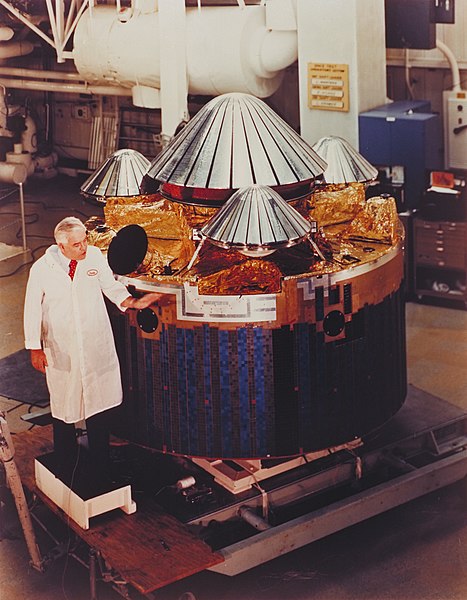The Pioneer Venus Multiprobe, also known as Pioneer Venus 2 or Pioneer 13, was a spacecraft launched in 1978 to explore Venus as part of NASA's Pioneer program. This part of the mission included a spacecraft bus which was launched from Earth carrying one large and three smaller probes, which after separating penetrated the Venusian atmosphere at a different location, returning data as they descended into the planet's thick atmosphere. The entry occurred on December 9, 1978.
Pioneer Venus Multiprobe
Pioneer Venus Bus with probes attached
Pioneer Venus Large Probe opens its parachute (artist's rendition)
Pioneer Venus Multiprobe infographic
The Pioneer programs were two series of United States lunar and planetary space probes exploration. The first program, which ran from 1958 to 1960, unsuccessfully attempted to send spacecraft to orbit the Moon, successfully sent one spacecraft to fly by the Moon, and successfully sent one spacecraft to investigate interplanetary space between the orbits of Earth and Venus. The second program, which ran from 1965 to 1992, sent four spacecraft to measure interplanetary space weather, two to explore Jupiter and Saturn, and two to explore Venus. The two outer planet probes, Pioneer 10 and Pioneer 11, became the first two of five artificial objects to achieve the escape velocity that will allow them to leave the Solar System, and carried a golden plaque each depicting a man and a woman and information about the origin and the creators of the probes, in case any extraterrestrials find them someday.

A family portrait showing (from left to right) Pioneers 6-9, 10 and 11 and the Pioneer Venus Orbiter and Multiprobe series
Reconstructed replica of Pioneer 1
Lunar flyby spacecraft (Pioneer 3, 4)
Pioneer P-1, P-3, 5, P-30, and P-31 probe








